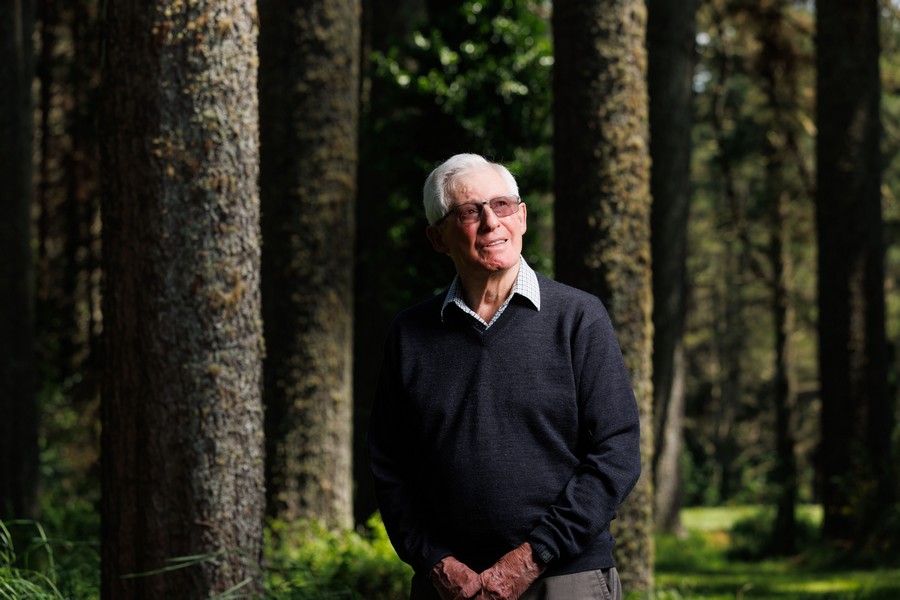'Final fling’ for retirees
21 December 2023
Retired by name, two scientists are still making contributions to forestry.
It was 1956 when Rowland Burdon joined the forest service as a technical trainee. Don Mead joined the following year.
Almost seven decades later and after long careers in forestry the pair are retired by name but not by nature.
In fact, they have recently published a joint paper titled “Lessons from insect and disease impact on radiata pine plantations in New Zealand over the last hundred years”.

Mead and Burdon’s histories in forestry are as extensive as that covered in the paper, published in the International Forestry Review.
Burdon, now an emeritus scientist at Scion, studied science at Canterbury University, then forestry at Oxford where he was shoulder-tapped to study genetics. He did PhD work on plant genetics in an agronomy environment at Aberystwyth then returned to New Zealand, to join Scion, then known as the Forest Research Institute, in late 1964.
Here he worked on the base and natural populations of radiata pine and inheritance within populations.
His work included quantitative breeding methodology, tree breeding strategy and risk management and involved most aspects of radiata pine’s general biology.
“I describe myself as a primarily a quantitative geneticist but known to have made a nuisance of myself in a number of other fields.”
Burdon officially retired in 2000 and worked part time for nearly 12 years before being appointed an emeritus.
Mead studied science at Victoria University, then forestry in Scotland, before becoming interested in tree nutrition during his time as a forester in Riverhead Forest.
“I looked at the foresters around me and they were all in the office and I wanted something more exciting, so I took a job with the Forest Research Institute (Scion) in 1965.”
He did his PhD at Florida State University and later taught forestry silviculture and forest ecology at Lincoln University but had wide interest in long-term sustainability, agroforestry, and bioenergy.
He retired in 1997 but continued his interest. The Rome-based Food and Agriculture Organisation of the United Nations published his book, Sustainable Management of Pinus radiata plantations, 10 years ago.
Then a couple of years ago, Mead, who now lives at the top of the South Island, heard someone talking about how radiata pine was “on its way out,” prompting this paper.
“I immediately thought of Rowland because he’s kept going in forestry as an emeritus at Scion and writing good stuff - so it was obvious we should get together.”
The pair hadn’t worked together before, but Mead says he followed Burdon’s fascinating work including a book published about radiata pine.

The resilience of radiata pine
For the paper, the pair reviewed the history of pest invasions affecting radiata in New Zealand over the last century and considered the potential for other diseases or insect pests to arrive.
“We found insect outbreaks or new diseases appear but often, depending on what it is, natural parasites will knock it back or we end up being able to live with it,” Mead says.
They looked at how disease incursions affected general growth rates and found rates had improved due to improved silviculture and research.
They also found that history showed the extinction of forest trees by new diseases or pests was extremely rare.
“There is always a possibility something may go wrong, and we might get something out of left field … Our first defense has to be things like quarantine,” Mead says.
“Really the question becomes how should we manage the future? Should we try diversifying into other species for example?”
To answer that, Burdon weighed incursion risks up against the costs and risks of growing alternative tree species.
He says in the past some intended “insurance” species often got into worse biotic trouble than radiata, putting it “evermore at the top of the list of preferred species”.
Various prospective back-up species are not commercially competitive for varied reasons, while radiata pine is resilient, site-tolerant and commercially attractive, they concluded.
“Despite a risk exposure to radiata pine in New Zealand, in a context of changing climates, the case for major pre-emptive diversification from this species is weak,” Burdon says.
The paper concluded radiata pine was still New Zealand’s best option for a medium-density softwood species for large-scale commercial forestry, but climate change may mean optimum growing areas could shift.
Scion funded the open access publication of the paper through the MBIE Strategic Science Investment Fund.
Peter Clinton, principal researcher at Scion, says the pair’s work has already inspired many researchers over many years and this joint work will be of interest to many who undertake research or grow radiata pine around the world, and here in New Zealand.
“The topic is of great relevance to the debate on impacts of climate related environmental change and the paper provides a timely reminder of the issues and importance of maintaining our forest biosecurity systems.”
For Mead and Burdon, retirement is still calling. Mead says the paper is a “final fling”.
But if retirement so far is anything to go by, that remains to be seen.
![]()
